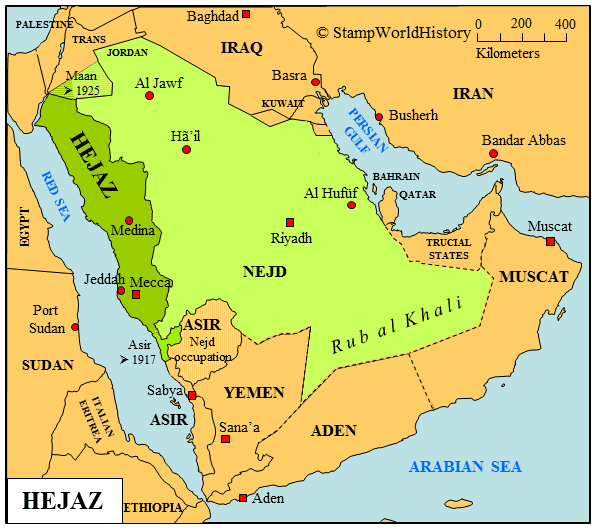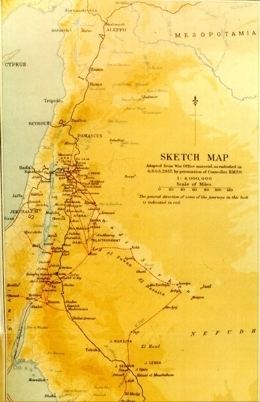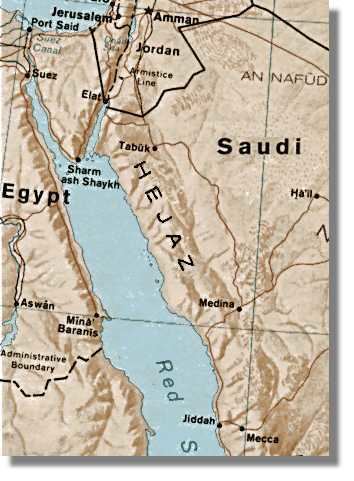 | ||
The Hejaz, also Al-Hijaz (Arabic: اَلْـحِـجَـاز, al-Ḥiǧāz, literally "the Barrier"), is a region in the west of present-day Saudi Arabia. The region is so called as it separates the land of the Najd in the east from the land of Tihamah in the west. It is also known as the "Western province." It is bordered on the west by the Red Sea, on the north by Jordan, on the east by the Najd, and on the south by ‘Asir Region. Its main city is Jeddah, but it is probably better known for the Islamic holy cities of Mecca and Medina. As the site of Islam's holiest places, the Hejaz has significance in the Arab and Islamic historical and political landscape.
Contents
- World walking explorer crosses saudi arabia s hejaz national geographic
- Prehistoric or ancient times
- Al Hijr Archaeological Site
- Era of Abraham and Ishmael
- Era of Muhammad
- Subsequent history
- Brief independence
- In modern Saudi Arabia
- Cities
- Geography
- People of the Hejaz
- Notable Hijazis
- Al Abwa
- Pre 6th century ACE
- 9th Century ACE
- 6th7th centuries ACE
- Post 7th century ACE
- References

Historically, the Hejaz has always seen itself as separate from the rest of Saudi Arabia. The Hejaz is the most populated region in Saudi Arabia; 35% of all Saudis live in Hejaz. Hejazi Arabic is the most widely spoken dialect in the region. Saudi Hejazis are of ethnically diverse origins.

The Hejaz is the most cosmopolitan region in the Arabian Peninsula. People of Hejaz have the most strongly articulated identity of any regional grouping in Saudi Arabia. Their place of origin alienates them from the Saudi state, which invokes different narratives of the history of the Arabian Peninsula. Thus, Hejazis experienced tensions with people of Najd.

World walking explorer crosses saudi arabia s hejaz national geographic
Prehistoric or ancient times
One or possibly two megalithic dolmen have been found in Al-Hijaz.

The Hejaz includes both the Mahd adh-Dhahab (Arabic: مَـهـد الـذّهـب, "Cradle of (the) Gold") (23°30′12.96″N 40°51′34.92″E) and a water source, now dried out, that used to flow 600 miles (970 km) north east to the Persian Gulf via the Wadi Al-Rummah and Wadi Al-Batin system. Archaeological research led by of Boston University and the University of Qassim indicates that the river system was active in 8000 BCE and 2500–3000 BCE.
The northern part of the Hejaz was part of the Roman province of Arabia Petraea.
Al-Hijr Archaeological Site

Saudi Arabia's first World Heritage Site that was recognized by the United Nations Educational, Scientific and Cultural Organization is that of Al-Hjir. The name "Al-Hijr" (Arabic: اَلْـحِـجْـر, "The Stoneland" or "The Rocky Place") occurs in the Qur’an, and the site is known for having structures carved into rocks, similar to Petra. Construction of the structures is credited to the people of Thamud. Despite their rather Polytheistic nature, a member of this folk was a Monotheistic preacher called 'Salih', after whom the site is also called "Mada’in Saleh" (Arabic: مَـدَائِـن صَـالِـح, "Cities of Saleh"). After the disappearance of Thamud from Mada’in Saleh, it came under the influence of other people, such as the Nabataeans, whose capital was Petra. Later, it would lie in a route used by Muslim Pilgrims going to Mecca.
Era of Abraham and Ishmael

According to Islamic sources, the civilization of Mecca started after Ibrahim (Abraham) brought his son Isma‘il (Ishmael) and wife Hajar (Hagar) here, for the latter two to stay. Some people from the Tribe of Jurhum settled with them, and Isma‘il reportedly married two women, one after divorcing another, at least one of them from this tribe, and helped his father to construct or re-construct the Ka‘bah, which would have social, religious, political and historical implications for the sight and region.
For example, in Arab or Islamic belief, a tribe called 'Quraysh' would descend from Isma‘il ibn Ibrahim, be based in the vicinity of the Ka‘bah, and include Muhammad ibn ‘Abdullah ibn ‘Abdul-Muttalib ibn Hashim ibn ‘Abd Manaf. From the Period of Jahiliyyah (Arabic: جَـاهـلـيّـة, 'Ignorance') to the days of Muhammad, the often-warring Arab tribes would cease their hostilities during the time of Pilgrimage, and go on pilgrimage to Mecca, as inspired by Ibrahim. It was during such an occasion that Muhammad met some Medinans who would allow him to migrate to Medina, to escape persecution by his opponents in Mecca.
Era of Muhammad
As the land of Mecca and Medina, the Hijaz was where Muhammad was born, and where he created a Monotheistic Ummah (Arabic: أُمَّـة, Community) of followers, bore patience with his foes or struggled against them, migrated from one place to another, preached or implemented his beliefs, lived and died. Given that he had both followers and enemies here, a number of battles or expeditions were carried out in this area. They involved both Meccan companions such as Hamzah ibn ‘Abdul-Muttalib, `Ubaydah ibn al-Harith and Sa`d ibn Abi Waqqas, and Medinan companions. The Hijaz fell under Muhammad's influence as he emerged victorious over his opponents, and was thus a part of his empire.
Subsequent history
Due to the presence of the two holy cities in the Hijaz, the region went under numerous empires. Al-Hijaz was at the center of the Rashidun caliphate, in particular whilst its capital was Medina from 632 to 656 ACE. The region was then under the control of regional powers such as Egypt and the Ottoman Empire, throughout much of its later history.
Brief independence
In 1916, Sharif Hussein ibn `Ali proclaimed himself King of an independent Hejaz, as a result of the McMahon–Hussein Correspondence. The ensuing Arab Revolt overthrew the Ottoman Empire. In 1924, however, Ibn `Ali's authority was replaced by that of Ibn Saud of the Najd.
In modern Saudi Arabia
At first, Ibn Saud ruled the two as separate units, though they became known as the Kingdom of Hejaz and Nejd. Later they were formally combined as the Kingdom of Saudi Arabia.
Cities
Geography
This area is situated along the Red Sea Rift and is distinguished by its darker, volcanic sand. The Hejaz region, as defined by certain criteria, encompasses the Sarawat Mountains, which serve as a topographical divide between Najd and Tehamah. Additionally, the region is notable for the plentiful presence of bdellium plants.
People of the Hejaz
People of Hejaz, who feel particularly connected to the holy places of Mecca and Medina, have probably the most strongly articulated identity of any regional grouping in Saudi Arabia.
The people of Hejaz have never fully accommodated to Saudi rule and their Wahhabi religion. They continue to be Sunni of Maliki rite with a Shia minority in the cities of Medina, Mecca and Jeddah. Many consider themselves more cosmopolitan because Hejaz was for centuries a part of the great empires of Islam from the Umayyads to the Ottomans.
